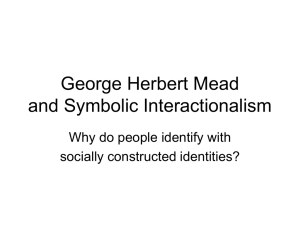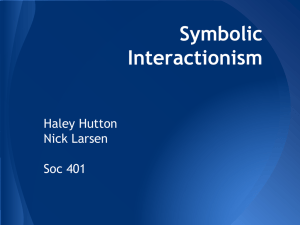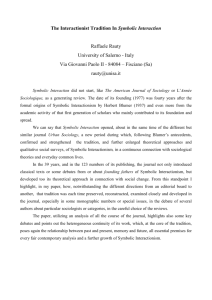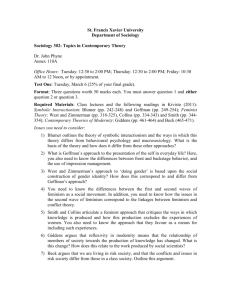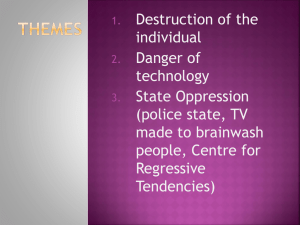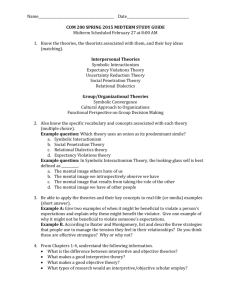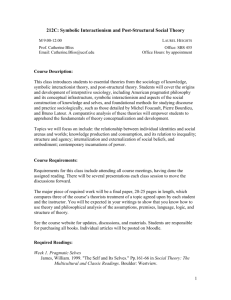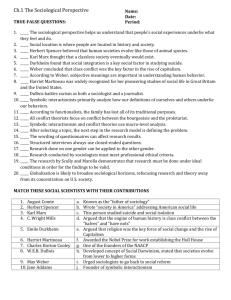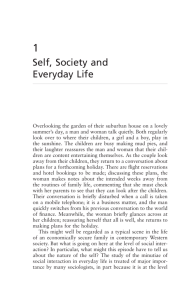Ch 06 Symbolic Interactionism
advertisement
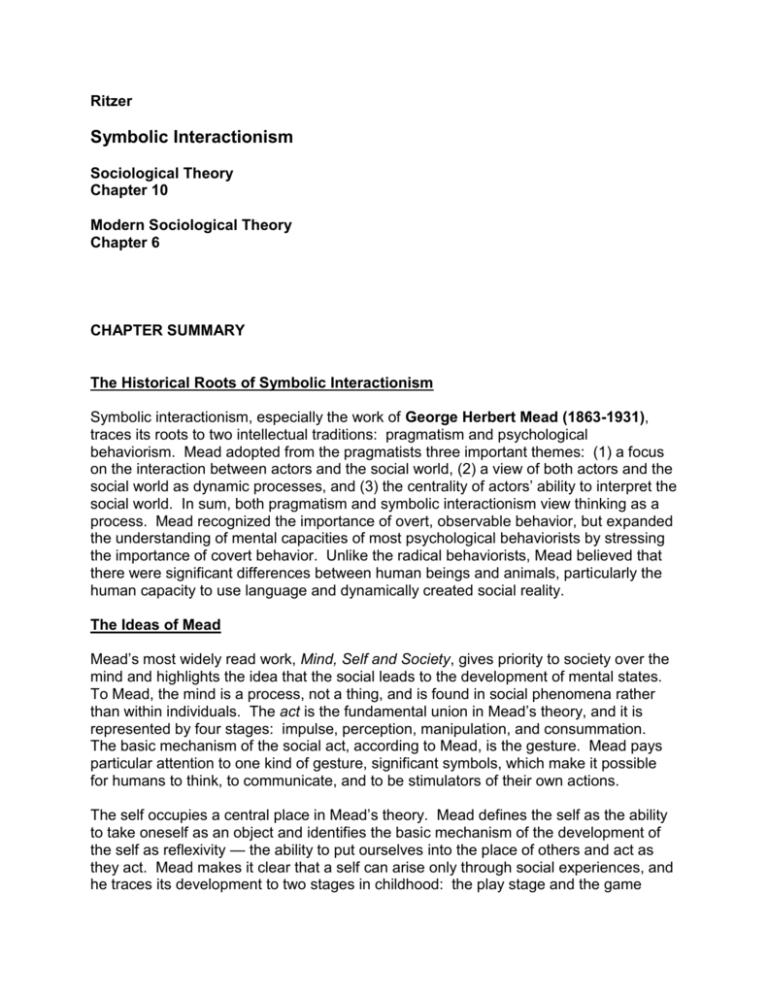
Ritzer Symbolic Interactionism Sociological Theory Chapter 10 Modern Sociological Theory Chapter 6 CHAPTER SUMMARY The Historical Roots of Symbolic Interactionism Symbolic interactionism, especially the work of George Herbert Mead (1863-1931), traces its roots to two intellectual traditions: pragmatism and psychological behaviorism. Mead adopted from the pragmatists three important themes: (1) a focus on the interaction between actors and the social world, (2) a view of both actors and the social world as dynamic processes, and (3) the centrality of actors’ ability to interpret the social world. In sum, both pragmatism and symbolic interactionism view thinking as a process. Mead recognized the importance of overt, observable behavior, but expanded the understanding of mental capacities of most psychological behaviorists by stressing the importance of covert behavior. Unlike the radical behaviorists, Mead believed that there were significant differences between human beings and animals, particularly the human capacity to use language and dynamically created social reality. The Ideas of Mead Mead’s most widely read work, Mind, Self and Society, gives priority to society over the mind and highlights the idea that the social leads to the development of mental states. To Mead, the mind is a process, not a thing, and is found in social phenomena rather than within individuals. The act is the fundamental union in Mead’s theory, and it is represented by four stages: impulse, perception, manipulation, and consummation. The basic mechanism of the social act, according to Mead, is the gesture. Mead pays particular attention to one kind of gesture, significant symbols, which make it possible for humans to think, to communicate, and to be stimulators of their own actions. The self occupies a central place in Mead’s theory. Mead defines the self as the ability to take oneself as an object and identifies the basic mechanism of the development of the self as reflexivity — the ability to put ourselves into the place of others and act as they act. Mead makes it clear that a self can arise only through social experiences, and he traces its development to two stages in childhood: the play stage and the game stage. During the play stage, children learn how to take the attitude of particular others to themselves, but it is only during the game stage that children learn how to take the roles of many others and the attitude of the generalized other. Mead also discussed the difference between the “I” and the “me” in his theory of the self. The “I” is the immediate response of an individual to the other; it is the unpredictable and creative aspect of the self. The “me” is the organized set of attitude of others that an individual assumes; it is how society dominates the individual and is a source of social control. The Basic Principles of Symbolic Interactionism The basic principles of symbolic interactionism include the following: (1) human beings possess the capacity for thought, which is shaped by social interaction; (2) people learn meanings and symbols through social interaction; and (3) people are able to modify or alter the meanings and symbols they use in interactions by interpreting the situations they are engaged in. Socialization is one way individuals learn to think, interact with one another, and understand how to use meanings and symbols. Defining the situation is another way that individuals actively engage in creating the social world. Finally, developing a “looking-glass” self helps individuals to perceive and judge the impressions we make on others we interact with. The Work of Goffman Erving Goffman (1922-1982) focused on dramaturgy, a view of social life as a series of dramatic performances, and he was interested in how the self is shaped by the dramatic interactions between social actors and their audiences. The basic unit of analysis in Goffman’s work is a team, which is any set of individuals who cooperate in staging a single act or routine. The central theme in his work is impression management, or the techniques that social actors use to maintain particular images of themselves when they encounter problems during interactions. As a general rule, most individuals feel the need to hide certain things about themselves when they are engaged in a performance. Goffman used the concepts of front stage, personal front, setting, appearance, manner, and back stage to discuss the theater of social life. According to Goffman, fronts tend to become institutionalized and are therefore selected rather than created. Personal fronts consist of appearance, or expressive equipment that tells the audience what kind of role the performer expects to play in a particular situation. The back stage is where actors engage in informal action that is suppressed when on front stage. Goffman also addressed the issue of stigma in his work. Stigmas emerge when there is a gap between a person’s virtual social identity and actual social identity. Goffman differentiated between discredited stigmas, which actors assume when their stigmas are evident to audience members (like loss of a nose) and discreditable stigmas, which audience members are unaware of unless an actor discloses this information (like his being infertile.) According to Goffman, we all possess some type of stigma, depending on the situations we are in. Later in his career Goffman moved away from symbolic interactionism to the study of small-scale structures or frames. Frames are understood by Goffman as rules that constrain social action and function to organize experience. He also described frames as the rituals of everyday life. Goffman’s move toward studying frames and rituals led him away from his earlier cynical view social life and brought him closer to Durkheim’s work The Elementary Forms of Religious Life. Criticisms of Symbolic Interactionism and Its New Directions Symbolic interactionism has been criticized for relying too much on qualitative methodology and for failing to incorporate quantitative methodology into its research program. It has also been criticized for being too vague on the conceptual front and for downplaying large-scale social structures. Given its micro-level focus, some have argued that symbolic interactionism is not microscopic enough, because it tends to ignore psychological factors. Symbolic interactionists are currently trying to answer some of these criticisms by integrating micro- and macro-level theories and synthesizing their approach across other fields of study. For example, some scholars are redefining Mead’s theory to show that it accounts for both micro- and macro-level phenomena. Others are using role theory as a way to integrate structure and meaning. Some symbolic interactionists are focusing more attention on culture and are working within cultural studies to examine the role communication technologies play in producing and representing social reality. Symbolic interactionism has changed considerably since its inception. According to one symbolic interactionist, Gary Fine, the field has fragmented, resulting in greater diversity. It has expanded beyond its concerns with micro-level relations, incorporated ideas from other theoretical perspectives, and been adopted by sociologists who would not define themselves as symbolic interactionists.
